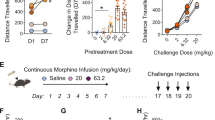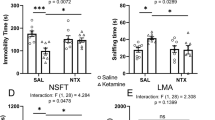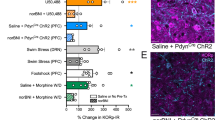Abstract
As prescription opioid analgesic abuse rates rise, so does the need to understand the long-term effects of opioid exposure on brain function. The dorsal striatum is an important site for drug-induced neuronal plasticity. We found that exogenously applied and endogenously released opioids induced long-term depression (OP-LTD) of excitatory inputs to the dorsal striatum in mice and rats. Mu and delta OP-LTD, although both being presynaptically expressed, were dissociable in that they summated, differentially occluded endocannabinoid-LTD and inhibited different striatal inputs. Kappa OP-LTD showed a unique subregional expression in striatum. A single in vivo exposure to the opioid analgesic oxycodone disrupted mu OP-LTD and endocannabinoid-LTD, but not delta or kappa OP-LTD. These data reveal previously unknown opioid-mediated forms of long-term striatal plasticity that are differentially affected by opioid analgesic exposure and are likely important mediators of striatum-dependent learning and behavior.
This is a preview of subscription content, access via your institution
Access options
Subscribe to this journal
Receive 12 print issues and online access
$209.00 per year
only $17.42 per issue
Buy this article
- Purchase on Springer Link
- Instant access to full article PDF
Prices may be subject to local taxes which are calculated during checkout







Similar content being viewed by others
References
Cicero, T.J., Inciardi, J.A. & Muñoz, A. Trends in abuse of oxycontin and other opioid analgesics in the United States: 2002–2004. J. Pain 6, 662–672 (2005).
Compton, W.M. & Volkow, N.D. Major increases in opioid analgesic abuse in the United States: concerns and strategies. Drug Alcohol Depend. 81, 103–107 (2006).
Manubay, J.M., Muchow, C. & Sullivan, M.A. Prescription drug abuse: epidemiology, regulatory issues, chronic pain management with narcotic analgesics. Prim. Care 38, 71–90 (2011).
Ordóñez Gallego, A., González Barón, M. & Espinosa Arranz, E. Oxycodone: a pharmacological and clinical review. Clin. Transl. Oncol. 9, 298–307 (2007).
Le Merrer, J., Becker, J.A.J., Befort, K. & Kieffer, B.L. Reward processing by the opioid system in the brain. Physiol. Rev. 89, 1379–1412 (2009).
Fallon, J.H. & Leslie, F.M. Distribution of dynorphin and enkephalin peptides in the rat brain. J. Comp. Neurol. 249, 293–336 (1986).
Finley, J.C., Lindström, P. & Petrusz, P. Immunocytochemical localization of beta-endorphin–containing neurons in the rat brain. Neuroendocrinology 33, 28–42 (1981).
Noble, F. et al. First discrete autoradiographic distribution of aminopeptidase N in various structures of rat brain and spinal cord using the selective iodinated inhibitor [125I]RB 129. Neuroscience 105, 479–488 (2001).
Strittmatter, S.M., Lo, M.M., Javitch, J.A. & Snyder, S.H. Autoradiographic visualization of angiotensin-converting enzyme in rat brain with [3H]captopril: localization to a striatonigral pathway. Proc. Natl. Acad. Sci. USA 81, 1599–1603 (1984).
Waksman, G., Hamell, E., Delay-Goyet, P. & Roques, B.P. Neuronal localization of the neutral endopeptidase 'enkephalinase' in rat brain revealed by lesions and autoradiography. EMBO J. 5, 3163–3166 (1986).
Dacher, M. & Nugent, F.S. Opiates and plasticity. Neuropharmacology 61, 1088–1096 (2011).
Dacher, M. & Nugent, F.S. Morphine-induced modulation of LTD at GABAergic synapses in the ventral tegmental area. Neuropharmacology 61, 1166–1171 (2011).
Drake, C.T., Chavkin, C. & Milner, T.A. Opioid systems in the dentate gyrus. Prog. Brain Res. 163, 245–263 (2007).
Iremonger, K.J. & Bains, J.S. Retrograde opioid signaling regulates glutamatergic transmission in the hypothalamus. J. Neurosci. 29, 7349–7358 (2009).
Iremonger, K.J., Kuzmiski, J.B., Baimoukhametova, D.V. & Bains, J.S. Dual regulation of anterograde and retrograde transmission by endocannabinoids. J. Neurosci. 31, 12011–12020 (2011).
Piskorowski, R.A. & Chevaleyre, V. Delta-opioid receptors mediate unique plasticity onto parvalbumin-expressing interneurons in area CA2 of the hippocampus. J. Neurosci. 33, 14567–14578 (2013).
Wamsteeker Cusulin, J.I., Füzesi, T., Inoue, W. & Bains, J.S. Glucocorticoid feedback uncovers retrograde opioid signaling at hypothalamic synapses. Nat. Neurosci. 16, 596–604 (2013).
Lovinger, D.M. Neurotransmitter roles in synaptic modulation, plasticity and learning in the dorsal striatum. Neuropharmacology 58, 951–961 (2010).
Smith, Y., Raju, D.V., Pare, J. & Sidibe, M. The thalamostriatal system: a highly specific network of the basal ganglia circuitry. Trends Neurosci. 27, 520–527 (2004).
Voorn, P., Vanderschuren, L.J.M.J., Groenewegen, H.J., Robbins, T.W. & Pennartz, C.M.A. Putting a spin on the dorsal-ventral divide of the striatum. Trends Neurosci. 27, 468–474 (2004).
Tepper, J.M., Abercrombie, E.D. & Bolam, J.P. Basal ganglia macrocircuits. Prog. Brain Res. 160, 3–7 (2007).
Jiang, Z.G. & North, R.A. Pre- and postsynaptic inhibition by opioids in rat striatum. J. Neurosci. 12, 356–361 (1992).
Miura, M., Saino-Saito, S., Masuda, M., Kobayashi, K. & Aosaki, T. Compartment-specific modulation of GABAergic synaptic transmission by μ-opioid receptor in the mouse striatum with green fluorescent protein–expressing dopamine islands. J. Neurosci. 27, 9721–9728 (2007).
Blomeley, C.P. & Bracci, E. Opioidergic interactions between striatal projection neurons. J. Neurosci. 31, 13346–13356 (2011).
Wilson, C.J. & Kawaguchi, Y. The origins of two-state spontaneous membrane potential fluctuations of neostriatal spiny neurons. J. Neurosci. 16, 2397–2410 (1996).
Gerdeman, G.L., Ronesi, J. & Lovinger, D.M. Postsynaptic endocannabinoid release is critical to long-term depression in the striatum. Nat. Neurosci. 5, 446–451 (2002).
Mathur, B.N., Capik, N.A., Alvarez, V.A. & Lovinger, D.M. Serotonin induces long-term depression at corticostriatal synapses. J. Neurosci. 31, 7402–7411 (2011).
Monory, K. et al. Opioid binding profiles of new hydrazone, oxime, carbazone and semicarbazone derivatives of 14-alkoxymorphinans. Life Sci. 64, 2011–2020 (1999).
Yoburn, B.C., Shah, S., Chan, K., Duttaroy, A. & Davis, T. Supersensitivity to opioid analgesics following chronic opioid antagonist treatment: relationship to receptor selectivity. Pharmacol. Biochem. Behav. 51, 535–539 (1995).
Francesconi, W., Berton, F., Demuro, A., Madamba, S.G. & Siggins, G.R. Naloxone blocks long-term depression of excitatory transmission in rat CA1 hippocampus in vitro. Arch. Ital. Biol. 135, 37–48 (1997).
Wagner, J.J., Etemad, L.R. & Thompson, A.M. Opioid-mediated facilitation of long-term depression in rat hippocampus. J. Pharmacol. Exp. Ther. 296, 776–781 (2001).
Drdla-Schutting, R., Benrath, J., Wunderbaldinger, G. & Sandkühler, J. Erasure of a spinal memory trace of pain by a brief, high-dose opioid administration. Science 335, 235–238 (2012).
Hoffman, A.F. & Lupica, C.R. Direct actions of cannabinoids on synaptic transmission in the nucleus accumbens: a comparison with opioids. J. Neurophysiol. 85, 72–83 (2001).
DiFeliceantonio, A.G., Mabrouk, O.S., Kennedy, R.T. & Berridge, K.C. Enkephalin surges in dorsal neostriatum as a signal to eat. Curr. Biol. 22, 1918–1924 (2012).
Nielsen, C.K. et al. δ-opioid receptor function in the dorsal striatum plays a role in high levels of ethanol consumption in rats. J. Neurosci. 32, 4540–4552 (2012).
Hiranuma, T. & Oka, T. Effects of peptidase inhibitors on the [Met5]-enkephalin hydrolysis in ileal and striatal preparations of guinea-pig: almost complete protection of degradation by the combination of amastatin, captopril and thiorphan. Jpn. J. Pharmacol. 41, 437–446 (1986).
Wang, H. & Pickel, V.M. Preferential cytoplasmic localization of δ-opioid receptors in rat striatal patches: comparison with plasmalemmal μ-opioid receptors. J. Neurosci. 21, 3242–3250 (2001).
George, S.R. et al. Distinct distributions of mu, delta and kappa opioid receptor mRNA in rat brain. Biochem. Biophys. Res. Commun. 205, 1438–1444 (1994).
Mansour, A. et al. Mu, delta and kappa opioid receptor mRNA expression in the rat CNS: an in situ hybridization study. J. Comp. Neurol. 350, 412–438 (1994).
Huerta-Ocampo, I., Mena-Segovia, J. & Bolam, J.P. Convergence of cortical and thalamic input to direct and indirect pathway medium spiny neurons in the striatum. Brain Struct. Funct. published online, 10.1007/s00429-013-0601-z (6 July 2013).
López-Moreno, J.A., López-Jiménez, A., Gorriti, M.A. & Rodríguez de Fonseca, F. Functional interactions between endogenous cannabinoid and opioid systems: Focus on alcohol, genetics and drug-addicted behaviors. Curr. Drug Targets 11, 406–428 (2010).
Hoffman, A.F., Oz, M., Caulder, T. & Lupica, C.R. Functional tolerance and blockade of long-term depression at synapses in the nucleus accumbens after chronic cannabinoid exposure. J. Neurosci. 23, 4815–4820 (2003).
Hohmann, A.G. & Herkenham, M. Localization of cannabinoid CB(1) receptor mRNA in neuronal subpopulations of rat striatum: a double-label in situ hybridization study. Synapse 37, 71–80 (2000).
Tempel, A. & Zukin, R.S. Neuroanatomical patterns of the mu, delta and kappa opioid receptors of rat brain as determined by quantitative in vitro autoradiography. Proc. Natl. Acad. Sci. USA 84, 4308–4312 (1987).
Fyfe, L.W., Cleary, D.R., Macey, T.A., Morgan, M.M. & Ingram, S.L. Tolerance to the antinociceptive effect of morphine in the absence of short-term presynaptic desensitization in rat periaqueductal gray neurons. J. Pharmacol. Exp. Ther. 335, 674–680 (2010).
Pennock, R.L. & Hentges, S.T. Differential expression and sensitivity of presynaptic and postsynaptic opioid receptors regulating hypothalamic proopiomelanocortin Neurons. J. Neurosci. 31, 281–288 (2011).
DePoy, L. et al. Chronic alcohol produces neuroadaptations to prime dorsal striatal learning. Proc. Natl. Acad. Sci. USA 110, 14783–14788 (2013).
Nazzaro, C. et al. SK channel modulation rescues striatal plasticity and control over habit in cannabinoid tolerance. Nat. Neurosci. 15, 284–293 (2012).
Acknowledgements
We extend special thanks to W. Xiong for his efforts in performing preliminary experiments for this study. This research was supported by the Division of Intramural Clinical and Biological Research of the National Institute on Alcohol Abuse and Alcoholism, US National Institutes of Health.
Author information
Authors and Affiliations
Contributions
B.K.A. planned experiments, conducted whole-cell recordings, injections and stereotaxic surgeries, analyzed data, and wrote the manuscript. D.A.K. conducted extracellular field recordings and wrote the manuscript. D.M.L. supervised and assisted in experimental planning and wrote the manuscript.
Corresponding author
Ethics declarations
Competing interests
The authors declare no competing financial interests.
Integrated supplementary information
Supplementary Figure 1 Field recordings reveal OP-LTD of net striatal output.
(a) DAMGO (1 μM, 5 min) induced mOP-LTD of population spike amplitude in field recordings of the DLS (vs. control: P=0.0219, t(12)=2.631, n=14). (b) DPDPE (1 μM, 5 min) induced dOP-LTD of population spike amplitude in field recordings of the DLS (vs. control: P=0.0047, t(14)=3.360, n=16). (c) U69,593 (1 μM, 5 min) induced kOP-LTD of population spike amplitude in field recordings of the DLS (vs. control: P=0.0317, t(14)=2.386, n=16). Representative traces are the average of the first 5 min (first of each pair) and the final 5 min (second of each pair) of recording. Scale bars: 0.2 mV, 2 ms. Data analyzed with unpaired Student's t-test.
Supplementary Figure 2 OP-LTD is equivalent at –60 mV and –80 mV holding potentials in DLS, but only mOP- and dOP-LTD occur in DMS.
(a) DAMGO (1 μM, 5 min) induced comparable mOP-LTD in MSNs recorded at -60 mV (n=11) and -80 mV in DLS (n=4), and at -60 mV in DMS (n=6) (at 25 min: P=0.3741, F(2,18)=1.039). (b) DPDPE (1 μM, 5 min) induced comparable dOP-LTD in MSNs recorded at -60 mV (n=7) and -80 mV in DLS (n=5), and at -60 mV in DMS (n=4) (at 25 min: P=0.6461, F(2,13)=0.4518). (c) U69,593 (0.3 μM, 5 min) induced comparable kOP-LTD in MSNs recorded at -60 mV (n=5) and -80 mV in DLS (n=5). U69,593 failed to induce LTD in DMS (n=6) (at 25 min: P=0.0075, F(2,13)=7.308). Data analyzed with a one-way ANOVA with Dunnett's multiple comparisons post-test: vs. DLS, -60 mV. *: P<0.05.
Supplementary Figure 3 mOP- and dOP-LTD are expressed presynaptically, whereas kOP-LTD has an unclear site of expression.
(a) Representative traces of sEPSCs recorded from a DLS MSN before, immediately after, and 20-25 min following DAMGO (0.3 μM, 5 min). DAMGO (0.3 μM, 5 min) induced a long-lasting increase in sEPSC inter-event interval (IEI) (b,c; P=0.0063, Friedman statistic=9.800, n=9) with no change in sEPSC amplitude (d; P=0.2223, Friedman statistic=3.200). (e) Representative sEPSC traces for DPDPE (0.3 μM, 5 min). DPDPE (0.3 μM, 5 min) produced a long-lasting increase in sEPSC IEI (f,g; P=0.0207, Friedman statistic=7.714, n=7) with no change in sEPSC amplitude (h; P=0.0854, Friedman statistic=5.429). (i) Representative sEPSC traces for U69,593 (0.3 μM, 5 min). U69,593 (0.3 μM, 5 min) produced no change in sEPSC IEI (j,k; P=0.0570, Friedman statistic=6.000, n=9), but produced a delayed decrease in sEPSC amplitude (l; P=0.0307, Friedman statistic=6.889). Scale bars: 20 pA, 2 s. Data in c-d, g-h, and k-l analyzed with Friedman test with Dunn's multiple comparisons post-test. *: P<0.05.
Supplementary Figure 4 The lack of an additive effect of a MOPr and a CB1 agonist suggests a presynaptically localized occlusiveness of mOP-LTD and CB1-LTD.
DAMGO (0.3 μM; n=5), WIN55,212-2 (1 μM, n=5), or their combination (n=6), each applied for 10 min, induced comparable magnitudes of depression (P=0.7797, F(2,13)=0.2537). Representative traces are the average of the first 10 min (first of pair) and the final 10 min (second of pair) of recording. Scale bars: 50 pA, 50 ms. Data analyzed with one-way ANOVA with Tukey's post-test.
Supplementary Figure 5 eCB-LTD is not blocked by opioid receptor antagonists, and OP-LTD is not blocked by a CB1 antagonist.
(a) Pre-application of the CB1 receptor antagonist, AM251 (3 μM), did not alter mOP-LTD induced by DAMGO (0.3 μM to 1 μM, 5 min; at 30 min:P=0.9836, t(8)=0.02127, n=5 each). (b) Pre-application of AM251 (3 μM) did not alter dOP-LTD induced by DPDPE (0.3 μM to 1 μM, 5 min; at 30 min: P=0.5996; t(9)=0.5441, n=5 control, n=6 AM251). (c) Pre-application of the opioid receptor antagonist, naloxone (2 μM), did not alter eCB-LTD induced by HFS paired with postsynaptic depolarization (at 30 min: P=0.6162, t(10)=0.5173, n=6 each). Data analyzed with unpaired Student's t-test.
Supplementary Figure 6 Expression of ChR2-Venus in hippocampus does not result in striatal ChR2-Venus expression.
(a) Lack of striatal expression of ChR2-Venus in striatum following an injection of AAV vector in hippocampus. Injection coordinates: A/P: -2.0, M/L: ± 0.35, D/V: -1.45. (b) AAV vector injection in hippocampus produces substantial ChR2-Venus expression at the injection site. Images are representative of 1 injected mouse. Scale bars: 1 mm.
Supplementary information
Supplementary Text and Figures
Supplementary Figures 1–6 (PDF 6422 kb)
Source data
Rights and permissions
About this article
Cite this article
Atwood, B., Kupferschmidt, D. & Lovinger, D. Opioids induce dissociable forms of long-term depression of excitatory inputs to the dorsal striatum. Nat Neurosci 17, 540–548 (2014). https://doi.org/10.1038/nn.3652
Received:
Accepted:
Published:
Issue Date:
DOI: https://doi.org/10.1038/nn.3652
This article is cited by
-
An endogenous opioid alters neuronal plasticity to constrain cognitive flexibility
Molecular Psychiatry (2023)
-
Astrocytes modulate extracellular neurotransmitter levels and excitatory neurotransmission in dorsolateral striatum via dopamine D2 receptor signaling
Neuropsychopharmacology (2022)
-
Highly-selective µ-opioid receptor antagonism does not block L-DOPA-induced dyskinesia in a rodent model
BMC Research Notes (2020)
-
Synapse-specific expression of mu opioid receptor long-term depression in the dorsomedial striatum
Scientific Reports (2020)
-
Dopamine and addiction: what have we learned from 40 years of research
Journal of Neural Transmission (2019)



